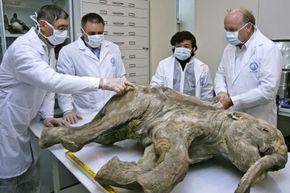Quck answer
Bringing extinct species back to life is a controversial issue. Some argue that it is necessary to restore the biodiversity of our planet and undo the damage caused by human activities. Others believe that it is unethical and that we should focus on preserving the species that are currently endangered. In addition, there are concerns about the safety and unintended consequences of reintroducing extinct species into their former habitats. While the technology to clone extinct animals exists, it is important to consider the potential risks and benefits before making any decisions. Ultimately, the decision to bring extinct species back to life should be made on a case-by-case basis, taking into account scientific, ethical, and environmental considerations.

Although science has advanced enough to allow for the possible de-extinction of some species, the question of whether or not reintroducing extinct animals is a good idea is one that is still hotly debated amongst scientists, politicians, conservationists, developers, ethicists, and the general public.
While the prospects of seeing a woolly mammoth or passenger pigeon may be exciting, there are many practical considerations that must be taken into account. For example, where would these reintroduced species be placed? How would we ensure their survival and increase their numbers? And how would they affect current ecosystems?
Passenger pigeons, which went extinct in 1914, are a prime example of the difficulties and potential pitfalls of de-extinction. These birds survived in flocks of millions and used their numbers to overpower food sources and protect themselves. However, the forests that supported these massive flocks no longer exist in abundance. Additionally, the last passenger pigeons held in captivity were unable to reproduce, adding yet another layer of complexity to the de-extinction process.
Some scientists believe that the passenger pigeon could be re-engineered to reproduce and thrive in captivity and smaller flocks, but this raises further questions about what exactly constitutes a “revived” species. Others argue that the resources and time spent on de-extinction should be directed towards saving endangered species that are still alive today.
Both sides present valid arguments, and until the first species is successfully revived, we cannot know what the ramifications of reintroduction may be. However, it is clear that de-extinction is not a simple or straightforward process, and it is unlikely to lead to a real-life “Jurassic Park.”
Additional Information
Related Articles
- Discovering How Extinction Occurs
- Top 10 Animals That Are No Longer Existing
- What Causes the Possible Extinction of Fish in 40 Years?
- How Did the Bald Eagle Recover from Endangered Status?
- What Saved the Bison from Almost Becoming Extinct?
References
- Brand, Stewart. “The Argument for Bringing Back Extinct Species.” National Geographic. March 11, 2013. (Jan. 18, 2015.) http://news.nationalgeographic.com/news/2013/03/130311-deextinction-reviving-extinct-species-opinion-animals-science/
- Pimm, Stuart. “The Argument Against Species Revival.” National Geographic. March 12, 2013. (Jan. 18, 2015) http://news.nationalgeographic.com/news/2013/03/130312–deextinction-conservation-animals-science-extinction-biodiversity-habitat-environment/
- Switek, Brian. “Recreating the Mammoth.” National Geographic. March 19, 2013. (Jan. 18, 2015) http://phenomena.nationalgeographic.com/2013/03/19/reinventing-the-mammoth/
- Yeoman, Barry. “Billions to None.” Audubon Magazine. May-June 2014. (Jan. 18, 2015) http://www.audubonmagazine.org/articles/birds/why-passenger-pigeon-went-extinct
- Zimmer, Carl. “Reviving Extinct Species.” National Geographic. April 2013. (Jan. 18, 2015) http://ngm.nationalgeographic.com/2013/04/125-species-revival/zimmer-text
FAQ
1. What is de-extinction?
De-extinction is the process of bringing extinct species back to life through genetic engineering.
2. What are the benefits of bringing extinct species back to life?
The benefits of de-extinction include restoring ecosystems that have been damaged by the extinction of a particular species, preserving biodiversity, and potentially advancing medical research through the study of extinct species.
3. What are the risks of bringing extinct species back to life?
The risks of de-extinction include the potential for unintended consequences, such as the introduction of new diseases or the disruption of existing ecosystems, as well as the ethical concerns surrounding the creation of new life forms.
4. What species have been de-extincted?
So far, only a handful of species have been de-extincted, including the Pyrenean ibex and the woolly mammoth (which is still in the early stages of the de-extinction process).
5. How is de-extinction accomplished?
De-extinction is accomplished through genetic engineering, which involves extracting DNA from extinct species and using it to create a clone or hybrid.
6. Is de-extinction ethical?
There is no easy answer to this question, as the ethics of de-extinction are complex and controversial. Some argue that it is our responsibility to restore the damage we have done to the environment, while others argue that playing God with nature is inherently wrong.
7. What are the potential long-term effects of de-extinction?
The potential long-term effects of de-extinction are unclear, as it is a relatively new field. However, it is possible that de-extinction could have unintended consequences that could impact the environment and other species.
8. How much does de-extinction cost?
De-extinction is a very expensive process, with estimates ranging from hundreds of thousands to millions of dollars per individual animal.
9. Who is funding de-extinction research?
De-extinction research is primarily funded by private organizations, such as the Long Now Foundation and Revive & Restore.
10. Is de-extinction a viable solution to the problem of extinction?
De-extinction is not a viable solution to the problem of extinction, as it does not address the root causes of extinction, such as habitat destruction and climate change.
11. What is the future of de-extinction?
The future of de-extinction is uncertain, as it is a relatively new field with many ethical and practical challenges to overcome. However, it has the potential to be a valuable tool for conservation and scientific research if used responsibly and thoughtfully.





Leave a Reply